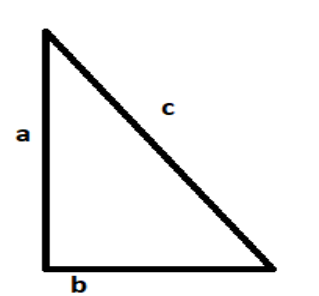
The value of$\cos \theta $ increases as $\theta $ increases. Enter 1 for true and 0 for false.
Answer
585.6k+ views
Hint: Look at the graph of cosine and check in the interval from 0 to 180. If the value of $\cos \theta $ increases as $\theta $ increases then the answer is 1 else it is 0.
Complete step-by-step answer:
For a right angled triangle, the ratio of the sides gives certain trigonometric functions.
$\cos \theta $is the ratio of the base and the perpendicular. So, $\cos \theta = \dfrac{b}{c}$.

Similarly, one can get the other trigonometric ratios as well by taking different sets of sides.
For different angles, one can plot the variation of this function with the varying angle$\theta $.
The graph of $\cos \theta $looks like:

The cosine function has the following properties:
It is a decreasing function from 0 to 180.
It is symmetric about the y axis.
It has $2\pi $ as its period.
In the interval 0 to 90 we can see that as the angle $\theta $ is increasing the function $\cos \theta $ will decrease from 1 to 0 and on further going from 90 to 180 the function takes values from 0 to -1. So, it is clear from the graph that the cosine function decreases in the interval 0 to 180.
So, the correct answer is a false so we enter 0.
Note: Since no interval was mentioned in the question the standard domain of 0 to 180 was taken. Otherwise, the graph is a sinusoidal curve and is either decreasing or increasing, according to the interval.
Complete step-by-step answer:
For a right angled triangle, the ratio of the sides gives certain trigonometric functions.
$\cos \theta $is the ratio of the base and the perpendicular. So, $\cos \theta = \dfrac{b}{c}$.

Similarly, one can get the other trigonometric ratios as well by taking different sets of sides.
For different angles, one can plot the variation of this function with the varying angle$\theta $.
The graph of $\cos \theta $looks like:

The cosine function has the following properties:
It is a decreasing function from 0 to 180.
It is symmetric about the y axis.
It has $2\pi $ as its period.
In the interval 0 to 90 we can see that as the angle $\theta $ is increasing the function $\cos \theta $ will decrease from 1 to 0 and on further going from 90 to 180 the function takes values from 0 to -1. So, it is clear from the graph that the cosine function decreases in the interval 0 to 180.
So, the correct answer is a false so we enter 0.
Note: Since no interval was mentioned in the question the standard domain of 0 to 180 was taken. Otherwise, the graph is a sinusoidal curve and is either decreasing or increasing, according to the interval.
Recently Updated Pages
Master Class 12 Business Studies: Engaging Questions & Answers for Success

Master Class 12 Economics: Engaging Questions & Answers for Success

Master Class 12 English: Engaging Questions & Answers for Success

Master Class 12 Maths: Engaging Questions & Answers for Success

Master Class 12 Social Science: Engaging Questions & Answers for Success

Master Class 12 Chemistry: Engaging Questions & Answers for Success

Trending doubts
What is meant by exothermic and endothermic reactions class 11 chemistry CBSE

Which animal has three hearts class 11 biology CBSE

10 examples of friction in our daily life

One Metric ton is equal to kg A 10000 B 1000 C 100 class 11 physics CBSE

1 Quintal is equal to a 110 kg b 10 kg c 100kg d 1000 class 11 physics CBSE

Difference Between Prokaryotic Cells and Eukaryotic Cells




